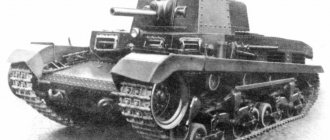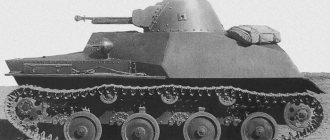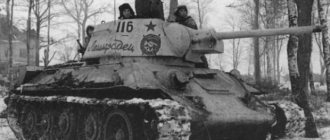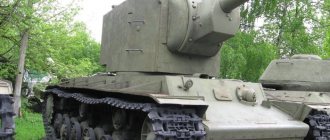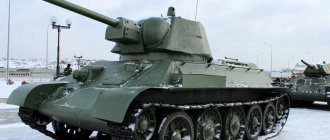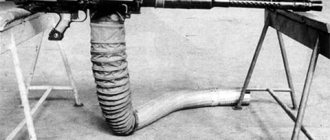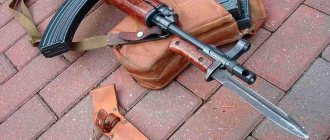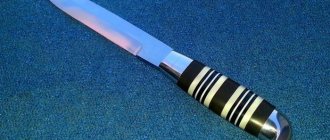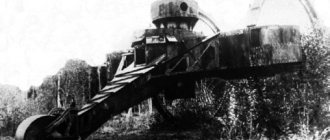Panzerkampfwagen III (PzKpfw III)
The combat vehicle, also known as the T-III, was a tank with a 37 mm caliber gun. It had 30mm armor on each side. The main function is speed (on the highway it gave 40 kilometers per hour). Other advantages of the tank are excellent optics, optimally located seats for the crew, and a radio station. Having all this, the Panzerkampfwagens fought successful battles with heavier vehicles.
However, when the opponents acquired new, more advanced vehicles, the “troika” began to be noticeably inferior to them. As a result, German designers increased the caliber of the tank gun, making it 50 mm. In addition, the tank was covered with hinged screens. In the end, this yielded results; the PzKpfw III fought for many more years. But in 1943, the production of combat vehicles was stopped because experts considered that the tank could no longer be modernized. Over the course of history, 5 thousand T-IIIs were produced in Germany.
"Jagdpanther" (Germany)
The Jagdpanther was one of the most powerful tank destroyers of World War II. It was based on the Panther chassis, entered service in 1943 and served until 1945. Armed with an 88mm gun with 57 rounds and 100mm frontal armor. The gun maintained accuracy at a range of up to three kilometers and had an initial speed of more than 1000 m/s.
A total of 415 tanks were built during the war. The Jagdpanthers were christened in a fire on July 30, 1944, near Saint-Martin-des-Bois, France, where eleven Churchill tanks were destroyed in two minutes. Technical superiority and advanced firepower did not greatly influence the course of the war due to the late appearance of these monsters.
Tank "Panther" (PzKpfw V Panther)
The Panther was developed in 1943 by MAN and was first used in the Battle of Kursk. German engineers sought to create a mass-produced tank that would be simple and cheap. The tank became a competitor to the Soviet T-34 and the “American” Sherman.
The new German development became the most powerful of the Wehrmacht tanks during the Second World War; it had very thick armor up to 80 millimeters thick. Enemy shells bounced off the tank's hull. True, the armor on the sides was thinner, so Soviet tank crews tried to hit precisely this “Achilles’ heel.”
The vehicle had a 75 mm gun, its power was not inferior to the Tiger's 88 mm cannon. Armor-piercing shells managed to fly a kilometer in the first second. Therefore, the combat vehicle was capable of hitting almost every enemy tank at a distance of over two kilometers. In terms of speed, the samples outperformed the T-34 - on the highway they could accelerate to almost 60 kilometers per hour.
Another thing is that the Panthers were expensive for German industry. In addition, their maintenance turned out to be difficult. The German economy was unable to properly organize their production. However, during the war years, about 6 thousand Panthers were produced.
Even in March 1945, during the fighting in Hungary, several hundred Panthers equipped with night vision devices attacked Red Army units near Lake Balaton. True, the technical innovation in the battle did not save them.
Tracks or wheels
Dick, following an anonymous denunciation, was also arrested, and the designers of his bureau moved to the united design bureau, which was headed by Koshkin. Yuri Maskarev, sent from Leningrad Kirovsky, became the new director of the plant. Work on creating new machines continued. The main directions were the projects of the light tank A-20 (continuation of the work of the Dick Design Bureau) and A-32. In basic features, the models were similar: the V-2 diesel engine, sharp corners of the armor plating (this idea belonged to the designer N.F. Tsiganov), and a welded turret.
But the A-20, in accordance with the technical specifications, was wheeled and tracked, like its “ancestors” of the BT series. The A-32 had only a caterpillar drive - it was originally even called A-20G in the drawings, that is, “tracked”. At that time, the service life of tank tracks was very small, so it was assumed that the tank would travel on the highway on wheels, and go into battle over rough terrain on tracks. But the designers managed to increase the resource, so they, on their own initiative, decided to abandon the wheels. Thanks to this, there was a potential opportunity to strengthen the armor and install a more powerful 76-mm gun.
Victorious
T-34 tank prototype on fire, 1940
Photo: commons.wikimedia.org
To voluntarily go beyond the scope of government assignments required great courage and faith in success. At a meeting in the Kremlin in February 1939, where Koshkin and Yuri Maksarev brought designs for two tanks, the designer even dared to start an argument with the military who did not believe in a purely tracked tank. As a result, the decisive factor was the opinion of Stalin, who supported the initiative of the Kharkovites and invited them to make prototypes of both tanks. Under their personal responsibility.
The last barrier: what was the feat of the Podolsk cadets
They couldn't stop the enemy, but they bought time
By May, the experimental A-20 was ready and began factory testing, the A-32 was made next, and its testing began in mid-summer. In August, both vehicles were sent to the troops for testing. The tanks performed well, but the head of the ABTU of the Red Army D.G. Pavlov expressed a wish for a significant increase in armor. Then the A-32 tank was loaded with 5 tons of cargo, after which it went for the second round of sea trials. There was a risk that the situation with the BT-7 would repeat itself, when some components and assemblies could not cope with the additional weight, but the designers now better understood the possible “pain points” of the vehicle.
During testing, the 19-ton tank, loaded to 24 tons, covered 1,534 km at an average speed of 28.2 km/h. Depending on road and ground conditions, the fuel supply was enough for 235–333 km. In general, the tank coped well - the engine, chassis and, most importantly, the gearbox modernized by Morozov’s group worked reliably. Now it was possible to double the armor protection (from 20 to 45 mm), which would allow the tank to be practically invulnerable to field anti-tank guns of 37 and 45 mm caliber.
Based on the test results, on December 19, 1939, the Defense Committee under the Council of People's Commissars of the USSR adopted Resolution No. 443 on the adoption of the A-32 tank for service. The terms of reference specified that the tank should be exclusively tracked, with 45 mm of frontal armor. The new car received the serial index T-34. Now it was not a light, but a medium tank, and its armament even exceeded the military’s needs due to the installation of a new L-11 tank gun. The speed remained quite high - more than 55 km/h.
Victorious
Soviet T-34 tanks on the offensive, 1943
Photo: RIA Novosti/Alexander Ustinov
Hot ice: how the Road of Life saved Leningrad during the siege
80 years ago the first convoy passed across the ice of Lake Ladoga
Tank IS-2 (“Joseph Stalin”)
The Joseph Stalin-2 combat vehicle became a worthy response to the Tiger from the Soviet military industry. It was published in 1943. It became the most powerful and most armored of the USSR wartime combat vehicles and one of the best in the world at that time. Engineers from the Soviet Union achieved an economical design.
The mass of the combat vehicle was comparable to the weight of the Panther, while the tank was much better protected by armor. The thickness of the armor reached millimeters. The gun was incredibly powerful in terms of firepower, its caliber reached 122 millimeters. Its shells shot right through Wehrmacht vehicles, pierced brickwork and demolished entire houses. The armament was supplemented by a 12.7 mm DShK machine gun located on the turret. Machine gun bullets did not allow the enemy to rest even behind the thick walls of buildings.
Therefore, IS-2s played an important role in the battles of 1944-1945, and were especially distinguished during assault operations, for example, in large cities. The tactical actions were as follows. In the city, assault groups of 1-2 vehicles operated along with companies consisting of machine gunners, a sniper, and sometimes a flamethrower. The tanks simply swept away the fascist resistance and, together with the soldiers sitting on them, broke through the streets into squares, squares, and parks. Here there was an opportunity to arrange a perimeter defense.
The disadvantages of the IS-2 included the too dense placement of fuel tanks in the control room. If an enemy shell penetrated the armor, the team most often died. The greatest risk fell on the driver - he did not have his own hatch, so he did not have time to get out of the car.
In addition, many unreliable samples that were not properly tested were sent to the active troops in a hurry. The problem was solved only with the modernization of the model, which was completed by 1945. The tank that liberated the peoples of Europe from fascism became a symbol of Victory. The Soviet army used it for almost 50 years.
T-4 - German medium tank
Units produced: 8686 pieces Weight: 25 tons Weapons: 75 mm caliber cannon, two 7.92 mm caliber machine guns Crew: 5 people Speed on the ground: 25–30 km/h
In German it was called Panzerkampfwagen IV (PzKpfw IV), that is, battle tank IV, and in the Soviet tradition it was designated as T-IV, or T-4. It became the most popular Wehrmacht tank in the entire history of its existence and was used in all theaters of war where German tank crews were present. The T-4 is, perhaps, the same symbol of German tank units as the T-34 became for Soviet tankers.
Panzerkampfwagen IV (PzKpfw IV)
Panzer IV entered the active German army in 1939. It became the most popular of the German tanks of the war period, with 8,700 combat units built.
It combined all the advantages of the light T-III, moreover, it had a more powerful weapon and was better protected. The frontal armor was up to 80 millimeters thick, and 75-millimeter shells easily penetrated the armor of enemy combat vehicles.
However, the combat unit had weak points - the sides and rear with very thin armor (at first the thickness was only 30 millimeters). In addition, the creators did not equip inclined armor plates for manufacturability and comfort for the crew.
He took part in many battles of World War II in areas with various combat conditions. It became the most popular combat vehicle of the Wehrmacht. It was as popular with the Nazis as the Sherman was with the American army or the T-34 with the Soviet troops. It had a well-developed and generally reliable design. In the first period of the war, it had an advantage over the tanks of the countries of the anti-Hitler coalition.
True, in fights with the T-34 and Sherman, the PzKpfw IV gun was powerless. Only in 1941 did the Germans improve the model, equipping it with a new rapid-fire cannon and stronger armor. This helped improve his combat performance. Despite this, over 7 thousand Panzerkampfwagen IVs were shot down in the battles of World War II. However, the Quartets were used by French and Czechoslovakian forces until the early 1950s and took part in the 1967 Arab-Israeli War.
M4 Sherman - American medium tank
Units produced: 49,234 units Weight: 30.3 tons Weapons: 75/76/105 mm caliber cannon, 12.7 mm caliber machine gun, two 7.62 mm caliber machine guns Crew: 5 people Speed on the ground: 40 km/ h
The Sherman tank is named after the hero of the American Civil War, General William Sherman, - the M4 was first received in Great Britain, and only then it became common to all tanks of this model. And in the USSR, where Lend-Lease M4s were supplied from 1942 to 1945, it was most often called “emcha”, according to the index. In terms of the number of tanks in service with the Red Army, the M4 was second only to the T-34 and KV: 4,063 Shermans fought in the USSR.
M4 Sherman tank
The main tank of the American army during the Second World War proved itself to be excellent on the battlefield. He also fought on the Soviet-German front; vehicles were supplied to the Soviet Union under Lend-Lease since 1942. In total, the Allies supplied the Red Army with 3,600 tanks.
By the way, the officers of the Soviet troops really liked the Shermans. Even elite Soviet units, for example, the 10th Guards Mechanized Corps, moved to them. However, popularity came to the combat unit only after its massive use in 1944, during the opening of the “second front” in Normandy.
For that time, the Sherman had good firepower, reliable armor, and high mobility. At the same time, he was reliable. The American combat vehicle was the first of the tanks to have a hydraulic turret drive, which improved the gun's pointing accuracy. In addition, a stabilizer for positioning the gun in a vertical plane appeared.
The Sherman was the first tank with a hydraulic turret drive (this ensured special pointing accuracy) and a gun stabilizer in the vertical plane. According to tank crews, in duels of combat vehicles their shot would be the first. The Sherman's advantages also included reduced engine noise, making the tank able to be used in covert operations, for example, in reconnaissance raids.
It is interesting that by the beginning of the war the United States had only 50 tanks in service, but already during World War II they were able to create an optimal combat unit. By 1945, 49 thousand Shermans of various modifications were produced. These included:
- "Firefly", used to hunt enemy tanks, its armament consisted of a 17-pound cannon;
- "Jumbo" - a vehicle with heavy armor, assault version;
- "Duplex Drive", an amphibious tank that could overcome water obstacles.
Of course, the tank had its drawbacks. Initially, their guns were quite weak and could not penetrate the armor of the German Tigers and Panthers. The shortcoming was eliminated by the release of a new modification, the M4A3E8 Sherman Easy 8. The combat unit received a strong engine, making it possible to move quickly. The tank acquired new, improved tracks, the suspension was modified, and a new 76-mm cannon appeared, which penetrated enemy armor.
However, the Sherman was still rather clumsy - it was noticeably inferior in speed to the T-34, having similar weapons. After the Second World War they continued to be used on the battlefield.
It was used in the Middle East conflict, here it operated until the 70s of the 20th century. The Chilean army was armed with separate models at the end of the twentieth century.
9. "Sherman-Firefly" (UK)
The Sherman Firefly was a British variant of the M4 Sherman, equipped with a devastating 17-pounder anti-tank gun, more powerful than the original 75 mm Sherman gun. The 17-pounder was destructive enough to damage all known tanks of the time. The Sherman Firefly was one of those tanks that terrorized the Axis powers and has been described as one of the deadliest fighting vehicles of World War II. In total, more than 2,000 units were produced.
INTERESTING Rating of the best ZTE / ZTE smartphones for 2022 (according to reviews)
Panzerkampfwagen VI Ausf. B Tiger II, "Tiger II"
After the appearance of the IS-2 heavy tank in the Red Army, the Wehrmacht set out to create a competitor to the Soviet “monster”. The Tiger II, also known as the “Royal Tiger,” became such a combat vehicle. He received his baptism of fire during the Allied landing in Normandy; the battalion of new Tigers knocked out 12 Shermans in the first clash.
In fact, the tank became a new modification of the first Tiger. It was equipped with special inclined armor and a large cannon of a larger caliber than before was added. In addition, an improved engine was installed on the tank. Thus, the combat unit was improved on different levels at once.
According to some estimates, it was the improved modification of the Tiger that became the most powerful vehicle of the Second World War; the tank was capable of radically tipping the scales in the other direction. True, it was designed quite late, towards the end of the war. The seriousness of the tank is indicated by the following: Wehrmacht tanker Kurt Knispel won 168 battles on it! Today, a copy of the combat unit can be seen in the Patriot Park museum in the Moscow region.
"Panther" - German medium tank
Units produced: 5976 pieces Weight: 45 tons Weapons: 75 mm caliber cannon, two 7.92 mm caliber machine guns Crew: 5 people Speed on the ground: 25–30 km/h
Panzerkampfwagen (PzKpfw) V Panther - or “Panther” for short. Unfortunately for the Soviet tank crews and artillerymen, the German tank was too tough for most of the Red Army's guns. But the Panther itself “bite” from afar: its 75-mm cannon penetrated the armor of Soviet tanks from distances at which the new German vehicle was invulnerable to them. And this first success gave the German command the opportunity to talk about making the T-5 (as the new tank was called in Soviet documents) the main one instead of the “veteran” T-4.
Tank T-34-85
The combat vehicle was created under wartime conditions in the USSR. It became an improved modification of the T-34 tank. A new tank was designed with a lack of resources and parts, using old technologies, in factories evacuated to the eastern part of the country. Often these enterprises were not originally intended to create military armored vehicles.
Despite all the obstacles, the tank acquired legendary status when it entered service in 1944. The basic T-34 model lacked fire support, so attacks were carried out in waves. The modified version was equipped with an 85 mm gun. The updated armor could withstand hits from a 37 mm cannon. In addition, an equipped room for the tank crew appeared, and an intercom was installed. Therefore, combat vehicles remained in service with the Soviet army even after the end of hostilities. Over 25 thousand combat vehicles of this modification have been created.
The modified T-34 model was a serious opponent for the heavily armed but slow fascist Tigers. Wehrmacht vehicles were significantly behind Soviet competitors in speed and maneuverability. Also, the T-34-85s were easy to maintain and repair. Red Army tankers quickly mastered the new vehicle and began to take full advantage of its speed and firepower. The new tank fully lived up to the hopes placed on it.
Based on the totality of its combat characteristics, the T-34-85 is considered one of the most effective tanks of the war.
M26 Pershing (USA)
The United States created a heavy tank that belatedly took part in World War II. It was developed in 1944, the total number of tanks produced was 2212 units. The Pershing was a more sophisticated model than the Sherman, with a lower profile and wider track, giving the vehicle better stability.
The main gun had a caliber of 90 millimeters (70 rounds were supplied), powerful enough to penetrate the Tiger's armor. The Pershing had the strength and power to frontally attack those vehicles that the Germans or Japanese could use. But only 20 tanks saw action in Europe and very few were sent to Okinawa. After the end of World War II, the Pershing took part in the Korean War and then continued to be used by American troops. The M26 Pershing could have been a game changer if it had been deployed to the battlefield sooner.
Tank KV-1 ("Klim Voroshilov")
The combat vehicle, created before the Great Patriotic War, also participated in the Soviet-Finnish War. After the German attack on the USSR, the tank was a thunderstorm for the Nazis. Not a single army in the world in 1941 had a weapon capable of equal resistance to the KV-1.
The tank was twice as heavy as the largest German combat vehicle. He destroyed elite units of German forces with the same ease as if he had participated in the Battle of Borodino in 1812. Until the end of 1941, it was an invincible, invulnerable and very powerful combat unit. Only at the end of the first year of the war did the Wehrmacht create competitive military equipment.
Weighed 45 tons, the protection of the combat unit consisted of 75 mm steel armor plates. The armor was well placed on the hull at an angle - German 37 caliber shells could not penetrate the tank’s defense even from a short distance. The Soviet “monster” had a long-barreled 76-caliber gun; it could reach the enemy at a distance of one and a half kilometers.
Tank teams were formed only from officers; only driver mechanics could bear the rank of sergeant major. The training of the crews was head and shoulders above the level of teams of other types of tanks.
The disadvantages of the tank include a rather undeveloped design; the vehicle was hastily put into mass production without taking into account the shortcomings. The transmission especially suffered. Due to the large mass of the tank and the serious loads associated with it, the chassis often failed. And in the initial period of the war, with frequent retreats, the vehicles had to be abandoned or blown up. It was impossible to repair them under military conditions.
The specimens captured by German troops never served the enemy. Due to breakdowns and lack of necessary parts, attempts by the Germans to use them were unsuccessful.
M3 "Stuart" - American light tank
Units produced: 23,685 units Weight: 12.7 tons Weapons: 37 mm caliber cannon, three to five 7.62 mm caliber machine guns Crew: 4 people Speed on the ground: 20 km/h
The M3 Stuart light tanks appeared in the American Army in March 1941, when it became clear that their M2 predecessors clearly did not meet the requirements of the time. But the “two” became the basis for the creation of the “troika”, inheriting both its advantages - high speed and operational reliability, and disadvantages - the weakness of weapons and armor and the terrifying cramped fighting compartment. But the tank was easy to manufacture, which allowed it to become the most popular light tank in the world.
Tank T-34 (“thirty-four”)
Developed by the design bureau of the Kharkov Locomotive Plant before the war. Mikhail Koshkin supervised the creation of the future masterpiece of the domestic tank industry. The combat vehicle was fast and was perfectly protected by sloped armor. In addition, the tank was equipped with a powerful 500-horsepower diesel engine and a 76-caliber gun. The transmission featured wide tracks.
In general, the design of the combat vehicle was simple and technologically advanced. Therefore, the military industry managed to establish its mass production very quickly. By mid-1942, 15 thousand vehicles had been produced, and in total during wartime the USSR produced over 84 thousand tanks of various modifications.
The Nazis were able to appreciate the Soviet creation already in the first battles; they experienced a strong shock. Fascist tanks could not compare with the “thirty-four” in cross-country ability. In addition, the Nazis nicknamed their 37 caliber cannon “knock-knock” because the shells hit the defense of the Soviet vehicle and bounced off. They were superior to German tanks in almost everything: armor thickness, maneuverability, speed and striking power. A meeting with our T-34s for German tankers meant one thing - a very likely defeat.
Even the military instructions for German tank crews stated that when meeting with the T-34, it is recommended not to engage in battle if possible. That is, experts advised their own subordinates to get far away from the Russian tank!
The disadvantages of the vehicle include difficulties in using optics, a small area of the conning tower and the lack of radio communications. Due to the small area of the fighting compartment, the tank commander had to serve as a gunner.
The weak link was also the transmission. She was in a special compartment in the stern. Therefore, the driveshaft turned out to be superfluous. The main role was played by control rods, 5 meters long. Therefore, it was difficult for the driver to control the car. To avoid transmission failure, tanks often went into battle in a single gear that had been set in advance.
These shortcomings forced the designers to modify the combat vehicle, resulting in the T-34-85.
Average... Became the best! How the USSR created a tank that became a legend of World War II
Average...became the best! How the USSR created a tank - a legend of World War II
In the museum and memorial complex “The History of the T-34 Tank” they talked about how the famous “thirty-four” was created, why it was assembled by women and children, and how this combat vehicle terrified the Nazis in the battles of Moscow and Stalingrad.
In its plans for world domination, Nazi Germany paid special attention to tank forces. “Steel rams” proved themselves brilliantly during the days of the enslavement of Europe. The Second World War became a “war of engines”, with a clear advantage of the German tank forces. Combined with mechanized infantry, aircraft and artillery, German tanks dominated any operation. The beginning of the invasion of the USSR in the summer of 1941, it would seem, anticipated the traditional “blitzkrieg victorious war” for the Third Reich. But this did not happen...
One of the stumbling blocks for Germany and all its allies was the Soviet medium tank T-34, which, by the way, German intelligence “slept through.” The Wehrmacht had to become familiar with this vehicle directly on the battlefield.
Vladimir Gorbunov, an employee of the museum and memorial complex “History of the T-34 Tank” - the only military history museum in the world that is entirely dedicated to a specific type of weapon - told the portal “History.RF” about how this machine was created and won its legendary victories. .
A tank that wasn't even in the drawings
– Vladimir Viktorovich, tell us, when the T-34 tank was put into service, what became its main feature?
– In the early 1930s, the Soviet Union began producing light wheeled-tracked high-speed tanks, widely known by the abbreviation BT. The machines turned out to be very successful - it would seem that there is a foundation for many years. But on the battlefield, special anti-tank artillery began to be used in increasing quantities. And it became clear that the bulletproof armor of “Betushki” (as the BT-5 and BT-7 tanks were affectionately called by Soviet tank crews) was already a thing of the past. There was a national need to create a tank capable of withstanding the impact of an anti-tank gun, a tank with shell-resistant armor.
Fulfilling, as they now say, a state task, the designers of Kharkov plant No. 183 developed two experimental tanks. The A-20 model became a direct continuation of the line of wheeled-tracked tanks. And in the A-32 model they abandoned the wheeled propulsion system, leaving only a caterpillar track. After very heated discussions and comprehensive tests, the tank was adopted by the Red Army on December 19, 1939... But actually, which one? The fact is that, having given preference to the A-32, the country’s military leadership in its decree immediately gave instructions to further strengthen the armor and armament of the tank, and this, initially transformed, model was assigned the index T-34. Generally speaking, they adopted a tank that was not even in the drawings. At the end of the 30s of the last century in our country this was a fairly common practice.
Pre-war tanks produced by plant No. 183. From left to right: A-8 (BT-7M), A-20, T-34 mod. 1940 with L-11 cannon, T-34 mod. 1941 with an F-34 cannon.
What was the “thirty-four” – a new type of tank? The inclined sides immediately catch your eye; the car resembles a truncated pyramid. Thus, the designers, with a frontal plate thickness of 45 mm, forced an enemy projectile flying horizontally to penetrate armor already 90 mm thick. By the way, new armor was created for the T-34 and KV tanks - it is especially strong. The next obvious difference between the T-34 is its wide nose. By the way, initially, to strengthen the bow of the tank, an armored beam was used, a kind of ram, allowing the vehicle to smash enemy heavy tanks, armored trains, and fortifications with a blow from the hull. Wide tracks in combination with a 500-horsepower diesel engine provided the tank with confident maneuverability in mud and snow drifts. And the very use of diesel made the tank more economical in fuel consumption and less fire hazardous in the event of being hit by an enemy shell. Let's add a tank gun with a caliber of 76.2 mm, powerful for those times, with a universal set of shots: to fight enemy armored vehicles, infantry, and fortifications. And, of course, what is now called a high level of technology. The tank turned out to be relatively simple: in manufacturing, operational maintenance, mastering by the crew, and repair. At the beginning of the Great Patriotic War, the Wehrmacht experienced all these delights to the fullest - from ordinary soldiers to military leaders!
– It’s true that in May 1942, complaints began to be received about defective T-34s, which is why the USSR State Defense Committee even adopted a special resolution on improving the T-34 tanks. What was the matter?
– Production of the T-34 began in 1940 in Kharkov and Stalingrad. The car is completely new. At the same time, mass production is being mastered, personnel are being trained and, at the same time, the design of the tank is being improved. A very difficult situation. Nevertheless, by the beginning of the Great Patriotic War, 1066 T-34 tanks entered the Red Army.
With the outbreak of the war, purely technical problems were supplemented by the mass evacuation of enterprises from the western regions of the USSR to the central part of the country, the disruption of industrial cooperation, and the deprivation of factories of some qualified personnel mobilized into the Red Army.
With the beginning of the war, new factories were involved in the production of the tank - in Gorky (now Nizhny Novgorod), Omsk, Sverdlovsk (now Yekaterinburg), Chelyabinsk.
All this, of course, had a negative impact on the quality of the tanks produced. And the corresponding decisions of state and military authorities were quite tough. But something else needs to be noted. Official discipline during the war years was complemented by the patriotic impulse of the workers themselves - to give the front as many high-quality tanks as possible. Hence there are a lot of rationalization proposals to improve the design of the machine and the most efficient production technologies. Even special all-Union conferences were held on improving tank production. Best practices spread throughout all enterprises at lightning speed!
There were also outstanding breakthroughs. Thus, thanks to the automatic submerged arc welding technology created under the leadership of Academician E. Paton, it was possible to minimize the human factor and increase the productivity of tank assembly almost tenfold.
T-34 was assembled by women, old people and teenagers
– The superiority of the T-34 was recognized by the Nazis themselves, including Colonel General Guderian, the creator of the German tank forces. Can we say that the T-34 was the best tank of all that took part in World War II?
– The question is not simple... Firstly, it was not for nothing that tanks of the 20th century were classified as small, light, medium and heavy. Each type has its own combat purpose. And to compare the merits of a light tank pursuing a retreating enemy with the qualities of a heavy tank, which at the very beginning of a combat operation ensured a breakthrough of enemy battle formations, to put it mildly, is stupid.
Secondly, if you listen to the jargon of modern fans of tank battles, then in relation to the T-34 we learn about “pies”, “nuts”, “tadpoles”. This is how post-war modellers dubbed various towers “thirty-four” - a reflection of various designs during the Great Patriotic War: from T-34 to T-34-85.
By the way, if not for the start of the war, the history of the T-34 would have actually ended in the fall of 1941. This machine at the factories was supposed to be replaced by the T-34M tank, which even in appearance is strikingly different from its predecessor.
By the way, the fact that the first version of the “thirty-four” was far from perfect was well known to both tank builders and tank crews in the pre-war years. But a big war was clearly approaching, and the country needed such a machine like air!
Thirdly, it is necessary to clearly understand the canons of domestic tank building. The T-34 tank was created with maximum efficiency for combat use with minimal amenities for its crew. Is it good? You can't say for sure. In any case, in many memoirs of tankers it is emphasized that they forgave the T-34 many shortcomings, because the tank provided the main thing for them: the opportunity to stay alive!
There is a fourth point. What to compare - T-34 or T-34-85? Let's add a question about comparing the T-34 and T-34-85 tanks. The name is actually the same, but the capabilities of the machines are very different...
Our museum has a special stand that allows you to compare the T-34 and T-34-85 with World War II tanks from Great Britain, Germany and the USA in terms of firepower, mobility and security. So the main “zest” is that during the Second World War, based on the totality of these most important combat properties, the “thirty-four” turned out to be the best medium tank. And today, three dozen achievements of the machine still remain in the rank of world records.
– Who created the legendary tank during the Great Patriotic War?
– Historical fact: the men drafted into the Red Army were replaced by women, veteran workers, and teenagers! The qualifications of most newcomers were measured at zero level. And then the technologists divided the production chain into separate closed operations, for which they prepared newcomers. Honor to the designers: their brainchild turned out to be accessible to workers of this category.
On the other hand, the same teenagers tried in every possible way to improve their qualifications. At the expense of time for personal recreation, girls and boys studied the intricacies of production. In Nizhny Tagil during the war, Anatoly Smirnov, for example, distinguished himself in the creation of “thirty-fours”. This happened when the advanced worker was only 15 years old! His peers achieved the honorary title of “Guards Brigade”. The girls received it because they exceeded the production quota three times every day.
Koshkin appeared in Kharkov at a terrible time
– In relation to the T-34, what is Koshkin’s personal merit?
– Mikhail Koshkin arrived in Kharkov at the beginning of 1937 after graduating from the Leningrad Mechanical Engineering Institute and practical work on the development of T-29 and T-46-5 tanks at Leningrad Plant No. 185, the quality of which was awarded the Order of the Red Star.
Terrible times began at the Kharkov plant: a big problem occurred with gearboxes on BT tanks, accusations of sabotage were made, and widespread arrests began.
Under these conditions, Mikhail Ilyich managed to retain the personnel of the design bureau. Koshkin formulated the main task for his colleagues extremely simply: to work not to catch up, but to overtake; in design, use not an analogue, but a trend; introduce a tank that would be promising for a long time...
Of the many options, the head of the design bureau, and then the chief designer of plant No. 183, chose the most effective one. He managed to defend this model right up to the highest government leadership.
Mikhail Koshkin literally gave his life for this tank. In September 1940, a few months before the start of the Great Patriotic War, the outstanding organizer passed away. But the idea has already been translated into metal!
– How did Koshkin’s death affect the further production of the tank?
– The T-34 tank, by and large, was very lucky. Avid enthusiasts worked on the creation of this machine. There was a real team of like-minded people, for whom the main thing was the task, the concrete result, and certainly the most effective one.
Koshkin's death was a shock, and not only for the design bureau. Kharkov tank building veterans recalled that virtually the entire city gathered at the funeral of the chief designer. But the vast majority of participants in the funeral ceremony did not even know the name of the deceased. Did the “sixth sense” work?..
But there was no time for deep feelings. The baton was taken up by Alexander Morozov, a designer from God, the future twice Hero of Socialist Labor, with whose name most of the most famous Soviet tanks are associated. Another colleague of Koshkin, Nikolai Kucherenko, became the permanent head of the design bureau during the years of operation of plant No. 183 in Nizhny Tagil. With their like-minded designers, they ensured the modernization of the T-34 tank, the creation of the T-34-85, and then the T-44 tank. We can say that the design bureau preserved the “Koshkinsky backlog” until the very end of the Great Patriotic War.
Tank on a medal
– The Germans suffered their first serious defeat in the Battle of Moscow. What role did the T-34 tanks play in this?
– The tank is immortalized on the medal “For the Defense of Moscow.” Moreover, this was done in 1944, when many fierce battles had already taken place on the fields of the Great Patriotic War, the opportunity arose to compare the successes and shortcomings of the T-34.
In the winter of 1941–1942 , a powerful vehicle on wide tracks easily overcame snow drifts. The Germans were in shock; they could not do anything to oppose our tank purely physically! By the way, the following winter, near Stalingrad, the Hungarian, Italian, Romanian and Finnish allies of Germany had to experience this.
Near Moscow, the “thirty-four” began to be used for the first time by fairly large forces - individual battalions, tank brigades. Tank landings became widespread: machine gunners and soldiers with light machine guns were located on the armor of the tank. This experience was useful in all subsequent years of the war. And in Stalingrad, the designers even developed special handrails for the hull and turret of the T-34, to make it more comfortable for the “armored infantry” during rapid movement off-road.
So it’s not in vain that the T-34 was immortalized on a state award dedicated to the defense of the capital!
– How did German tanks behave in such conditions?
– In our museum there is an opportunity to personally compare the T-34 track with the track of a German medium tank. The latter is small in size. That is why the ground pressure of German vehicles was much greater. That’s why they got hopelessly stuck: in the mud and soft ground in the summer, in the snowdrifts in the winter.
– Can we say that it was near Moscow that the main battle of the “thirty-four” took place?
– By the will of fate, the “thirty-four” in the guise of T-34 and T-34-85 participated in all the main battles of the Great Patriotic War. From Moscow to Berlin the tank went through the Battle of Stalingrad, through the fiery Kursk Bulge, through the liberation of Ukraine, Moldova, the Baltic republics, and then the countries of Eastern Europe. In the Red Army it became the most popular tank. Moreover, the bulk of the “thirty-four” were concentrated not at all in tank armies, as many people now think, but in combined arms formations. The vehicle went into battle along with the infantry, supporting the “queen of the fields” with its fire and protecting it with armor.
After the victorious May 1945, the “thirty-four” were awaiting trials in the Far East. Having overcome the famous Khingan Mountains, the 6th Guards Tank Army under the command of General A. Kravchenko took part in the defeat of the Japanese Kwantung Army.
– How to determine which of all the listed battles was the main one for the “thirty-four”?
In solving this problem, in my opinion, there is one very unexpected angle. I will take responsibility for the statement that the T-34 won its main battle at... the drawing board! The best confirmation of this is this: during the Second World War in the Third Reich, the famous “Panthers”, “Royal Tigers”, and the failed “Mouses” were created under the impression of our “thirty-four”. This is how history has placed everyone in their truly deserved places!
For those who are interested in the history of the T-34, we remind you that in April of this year the feature film “Tanks” directed by Kim Druzhinin was released. The film tells the fictional adventure story of designer Mikhail Koshkin's secret run on T-34 tanks to Moscow in order to approve the production of new tanks, which later helped the Soviet Union win the Great Patriotic War. The painting was created with the support of the Ministry of Culture of the Russian Federation and the Russian Military Historical Society. Details can be found here: https://www.culture.ru/s/tanki/ .
Tank Panzerkampfwagen VI Tiger I Ausf E, "Tiger"
The first "Tiger" became a heavy German tank, it was designed at the factories of the Henschel und Sohn company. The baptism of fire took place in 1942, during the siege of Leningrad.
The weight of the vehicle was 56 tons, the armament consisted of an 88-mm gun and two machine guns. The tank was protected by steel sheets 100 millimeters thick. The crew consisted of five people. The combat vehicle could dive 3.5 meters into the water.
It was created as a combat unit to break through enemy positions. He had to eliminate any enemy and put the enemy to flight. Hitler personally ordered the necessary technical equipment for the combat vehicle. Apparently, the Fuhrer's personal control led to the fact that the tank could fire 8 shells per minute, this was a record for large tank guns. The tank is usually described as slow, but on the highway the Maybach engine accelerated it to 45 kilometers per hour.
The German Tiger was one of the most dangerous combat vehicles of the initial stage of World War II. Its design was ahead of its time; it became a model for subsequent combat vehicles of a similar class. In 1942, Allied troops did not even hope to defeat it in direct combat, fearing the 88 mm gun. Enemy units tried to take the Tiger by surprise by unexpectedly approaching from behind.
The disadvantages of the combat vehicle include the complexity of the design, the high cost of production (the creation cost the same as the price of two Panther vehicles). In addition, the Tiger consumed a lot of fuel, and its chassis did not work well in severe frosts.
Each Tiger contained a technical manual with the inscription: “The tank costs 800 thousand Reichsmarks. Keep him safe!". As Goebbels believed, the soldiers should have rejoiced knowing that their combat vehicle was worth seven T-IV units. In fact, the military feared that something might happen inopportunely to the Tiger.
"Tigers" from movies and in life
However, it should be remembered that in real life very few German tanks of this type have survived, literally a few. “Tigers” are in the museum of armored vehicles in Kubinka and in the village of Snegiri, in the German museum in Münster, in the USA, in France - in Saumur and Vimoutiers, and in England, at the Bovington Camp base, and this machine is on the move there. Only their well-made copies are “played” in movies. Moreover, it is interesting that our Soviet T-44 tanks - the heirs of the famous "Thirty-Four" - are best suited for conversion into "Tigers". They were the ones who were made up to look like Tiger tanks for the film epic Liberation, and many were so amazed by them that people asked the question: “Where did they find so many Tigers?” Although it is clear that it is simply impossible to maintain such a military armada of old enemy tanks anywhere. However, it is very easy to distinguish a movie “Tiger” from a real one. Just look at its chassis: if you see only five large wheels in its tracked rim, then... it’s just a replica! On the real Tiger, the wheels were staggered, that is, some wheels were located in the spaces between others.
KV - Soviet heavy tank
Units produced: 4532 units Weight: 42.5–47.5 tons Weapons: 76/85 mm caliber cannon, three 7.62 mm caliber machine guns Crew: 4–5 people Speed on the ground: 10–15 km/h
“Klim Voroshilov” - and this is how the abbreviation KV stands for - became the first Soviet heavy tank of the classical design, that is, with a single turret rather than a multi-turret. And although the experience of its first combat use during the Winter War of 1939–1940 was not the best, the new vehicle was installed on the Arms. The military became convinced of how correct this decision was after June 22, 1941: even after several dozen hits from German guns, the heavy KVs continued to fight!
Foreign operators
Among them, I must name all the Axis countries during the onset of the first months of the war, which captured many tanks, as well as the Eastern European and Asian allies of the USSR, to whom many “boxes” were transferred closer to 1945.
Unfortunately, it is not possible to name the exact number, both because of the large number of foreign operators, and because the reports of that period often simply listed T-34s without taking into account what type it was: -76 or -85.
As an interesting detail, I would like to note that in the second decade of the 21st century, the “thirty-four” are in service with many third world countries, continuing their service.
T-3 - German medium tank
Units produced: 5865 units Weight: 25.9 tons Weapons: 37/50/75 mm caliber cannon, three 7.92 mm caliber machine guns Crew: 5 people Speed on the ground: 15 km/h
Although not as massive as the T-4, the Panzerkampfwagen (PzKpfw) III from mid-1941 to early 1943 formed the basis of the Panzerwaffe fleet - the tank forces of the Wehrmacht. And the reason for this is the system of determining the type of tank based on... weapons, which is strange for the Soviet tradition. Therefore, from the very beginning, the T-4, which had a 75-mm cannon, was considered a heavy tank, that is, it could not be the main vehicle, and the T-3, which had a 37-mm cannon, was classified as a medium tank and fully aspired to be the main battle tank.
